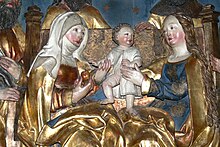Anna Triopa: Malsamoj inter versioj
| [kontrolita revizio] | [kontrolita revizio] |
Enhavo forigita Enhavo aldonita
Kani (diskuto | kontribuoj) Neniu resumo de redakto |
Kani (diskuto | kontribuoj) |
||
| Linio 6: | Linio 6: | ||
*[[Franca lingvo|Franca]]: ''Anne Trinitaire''<ref name="Murray">Murray, Peter et al. 2013. ''The Oxford Dictionary of Christian Art and Architecture.'' Oxford: Oxford University Press, p. 21.</ref> |
*[[Franca lingvo|Franca]]: ''Anne Trinitaire''<ref name="Murray">Murray, Peter et al. 2013. ''The Oxford Dictionary of Christian Art and Architecture.'' Oxford: Oxford University Press, p. 21.</ref> |
||
*[[Germana lingvo|Germana]]: ''Anna Selbdritt''<ref>Crăciun, Maria, & Elaine Fulton. 2011. ''Communities of Devotion: Religious Orders and Society in East Central Europe, 1450–1800.'' Farnham, UK: Ashgate, p. 50.</ref> |
*[[Germana lingvo|Germana]]: ''Anna Selbdritt''<ref>Crăciun, Maria, & Elaine Fulton. 2011. ''Communities of Devotion: Religious Orders and Society in East Central Europe, 1450–1800.'' Farnham, UK: Ashgate, p. 50.</ref> |
||
*[[Itala lingvo|Itala]]: ''Anna Metterza''<ref |
*[[Itala lingvo|Itala]]: ''Anna Metterza''<ref> Tinagli, Paola. 1997. Women in Italian Renaissance Art: Gender, Representation and Identity. Manchester: Manchester University Press, p. 159.</ref><ref name="Murray"/> |
||
*[[Slovena lingvo|Slovena]]: ''Ana Samotretja''<ref>Jaki, Barbara. 2004. ''National Gallery of Slovenia: Guide to the Permanent Collection: Painting and Sculpture in Slovenia from 13th to the 20th Century.'' Ljubljana: National Gallery of Slovenia, p. 9.</ref> |
*[[Slovena lingvo|Slovena]]: ''Ana Samotretja''<ref>Jaki, Barbara. 2004. ''National Gallery of Slovenia: Guide to the Permanent Collection: Painting and Sculpture in Slovenia from 13th to the 20th Century.'' Ljubljana: National Gallery of Slovenia, p. 9.</ref> |
||
Kiel registrite je 19:19, 18 sep. 2015

Anna Triopa estas - laŭ la Kristana Glosaro - la faktermino por skulptaĵo aŭ bildo trifigura kun Sankta Anna, la avino de Jesuo, de Sankta Maria, la filino de Anna kaj patrino de Jesuo kaj Jesuo, la filo de Maria kaj nepo de Anna. Tia bildo populariĝis ekzemple en Germanio kaj najbaraj landoj ekde la 14a jarcento.
Nomoj
Nomoj por tiu partikulara artotemo en diversaj lingvoj kiel la jenaj:
- Nederlanda: Anna te Drieën[1]
- Franca: Anne Trinitaire[2]
- Germana: Anna Selbdritt[3]
- Itala: Anna Metterza[4][2]
- Slovena: Ana Samotretja[5]
Notoj
- ↑ Dresen-Coenders, Lène et al. 1987. Saints and She-Devils: Images of Women in the 15th and 16th Centuries. London: Rubicon Press, p. 87.
- ↑ 2,0 2,1 Murray, Peter et al. 2013. The Oxford Dictionary of Christian Art and Architecture. Oxford: Oxford University Press, p. 21.
- ↑ Crăciun, Maria, & Elaine Fulton. 2011. Communities of Devotion: Religious Orders and Society in East Central Europe, 1450–1800. Farnham, UK: Ashgate, p. 50.
- ↑ Tinagli, Paola. 1997. Women in Italian Renaissance Art: Gender, Representation and Identity. Manchester: Manchester University Press, p. 159.
- ↑ Jaki, Barbara. 2004. National Gallery of Slovenia: Guide to the Permanent Collection: Painting and Sculpture in Slovenia from 13th to the 20th Century. Ljubljana: National Gallery of Slovenia, p. 9.
Literaturo
- Marlies Buchholz: Anna selbdritt. Bilder einer wirkungsmächtigen Heiligen. Langewiesche Nachfolger Köster, Königstein i. Ts. 2005, ISBN 3-7845-2113-4.
- Johannes H. Emminghaus: Anna Selbdritt. In: Lexikon der christlichen Ikonographie (LCI). Band 5, S. 185–190.
- Sigmund Freud: Eine Kindheitserinnerung des Leonardo da Vinci (= Schriften zur angewandten Seelenkunde. Bd. 7. Deuticke, Leipzig u. a. 1910 (Neuauflage. (= Fischer-Taschenbücher 5705). Fischer-Taschenbuch-Verlag, Frankfurt am Main 1982, ISBN 3-596-25705-0).
- Meyer Schapiro: Leonardo and Freud: An Art-Historical Study. In: Journal of the History of Ideas. Bd. 17, Nr. 2, 1956, ISSN 0022-5037, S. 147–178.
